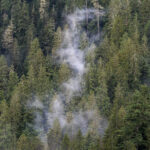What j-students need to know about protecting anonymous sources
The courts’ inconsistency on the question of anonymous sources, coupled with the absence of so-called shield laws in Canada, raises the question of whether a journalist should ever grant source anonymity, writes J-Source’s law editor Thomas Rose.
This is the first part of a weekly four-part series on legal issues young journalists should be cognizant about as they embark on their careers.
On Jan. 21, 2004, armed with a search warrant, members of the RCMP raided the offices of the Ottawa Citizen and the home of one of its journalists, Juliet O’Neill.
The police stated they were attempting to find the source of an internal leak that gave O’Neill privileged documents related to the Maher Arar case. At the time of the raid, questions were being raised over possible Canadian complicity in a decision by the United States in September 2002 to send Arar to Damascus, Syria. Arar, a Canadian citizen, had been identified by authorities on both sides of the border as a terrorist suspect. Deporting Arar to Syria rather than sending him back to Canada almost guaranteed that he would be imprisoned and tortured, which is exactly what happened.
The question in late 2003 and early 2004 focused on whether Arar was in fact a terrorist or associated with terrorists. The battle for public consensus on the matter played out in the media. O’Neill propelled herself and the Ottawa Citizen to the forefront of that debate when she wrote an article that all but convicted Arar as a terrorist suspect.
Related content on J-Source:
- Did journalists violate rights of B.C. terror suspects?
- Why hasn’t Mayor Rob Ford sued the Toronto Star?
- Opinion: On Brian Burke, journalism and Internet anonymity
O’Neill based her article on the contents of a secret dossier containing official government documents. It was this dossier and how it landed on O’Neill’s desk that prompted the RCMP to obtain a search warrant.
Notebooks, files, hard drives and other material were seized during the early-morning raid at O’Neill’s home.
The Security of Information Act was the new name for the former 1939 Official Secrets Act, a change made under omnibus anti-terrorism legislation the Canadian government introduced following the terrorist attacks in New York and Washington in 2001. Section 4 largely retained the wording of the former Official Secrets Act in criminalizing communication, possession, and retention of certain categories of government information labeled “secret,” “official” or “secret official” without prior authorization.
The RCMP document passed to O’Neill by an anonymous source fell under this category. O’Neill was threatened with charges of obtaining, possessing and “communicating,” i.e., publishing details from this file. If convicted, she could be jailed for up to 14 years.
O’Neill’s lawyers argued the raid was unconstitutional because it infringed on Charter guarantees of freedom of expression and freedom of the press. They argued that if allowed to stand, Section 4 of the Security of Information Act would shut down any legitimate exercise of that right by journalists investigating actions by the state.
Two years later, in a landmark ruling, an Ontario Superior Court Justice sided with O’Neill’s lawyers, stating categorically that the legislation as written violated Charter freedoms. The justice went on to stress that freedom of the press outweighs the needs of a criminal investigation if it appears the state is on a “fishing expedition.”
In other words, the court held that the search warrants obtained by the RCMP were a shield allowing the police to rummage about O’Neill’s belongings in hopes of finding evidence that could help them identify the insider who leaked the secret dossier about Arar.
But while the court was clear on issues of press freedom, it did not address the question of O’Neill’s anonymous source and whether a journalist can ever be compelled to reveal the identity of a source.
So, what does the law says about journalistic sources?
No blanket protection
The first thing to note is that Canada’s courts do not give journalists an absolute right to promise confidentiality to any source. Nor does Canada have so-called shield laws, common in the U.S., that protect the media’s sources.
In fact, the courts, judges, commissioners of public inquiries, Parliament and provincial legislatures all have the power to hold a journalist in contempt for refusing to divulge information, including the name of a confidential source.
On the other hand, in 2004, a court in Ontario recognized, for the first time, that journalists do have a legal right, entrenched in the Charter, to protect the identities of their sources, in certain cases.
Those last three words—in certain cases—speak volumes about the law and protecting sources.
In certain respects, the courts have significant leeway in deciding whether to punish a journalist for withholding the name of a source or to side with the journalist and protect her decision to withhold names. Which, of course, makes it somewhat frustrating for journalists.
There is a test most courts refer to when confronted with a matter dealing with unnamed sources. It’s called the Wigmore Test.
In 1905, John Henry Wigmore, dean of law at Northwestern University in Chicago, came up with four conditions that had to be met before a “communication,” be it spoken or written, could be considered privileged, i.e., beyond the reach of the courts.
The Supreme Court of Canada has been applying the Wigmore Test to cases involving journalistic sources since at least 1976. (See, for example, Slavutych v. Baker S.C.R.)
There are four essential elements of the Wigmore Test a journalist must meet in defence of a refusal to identify a source.
First, a journalist has to have made a promise to protect the identity of her source prior to entering into a relationship with the source.
Second, it must be shown that granting this confidentiality was essential in maintaining the relationship.
The importance of entering into such a relationship in the first place hinges on the third prong of Wigmore: that anonymity serves the public interest. In other words, a confidential relationship was created because the public had a significant interest in hearing what the protected source revealed to the journalist.
Finally, it must be shown that identifying an anonymous source would do more harm than good to the source and to the public interest.
In essence, these are the conditions a journalist must consider when agreeing to keep the identity of a source secret. However, and this is important, journalists also need to keep in mind that the courts are not obliged to use the Wigmore Test at all.
In January 2004, for example, in a case involving a reporter at the National Post, the Ontario Superior Court held that confidential sources were “essential to the effective functioning of the media in a free and democratic society.”
In other words, the court seemed to be saying that people may have justifiable reasons for wishing to remain anonymous such as fear of personal persecution (being humiliated within the community) or the fear of professional persecution (being fired or sued by an employer). “If employee confidentiality were to trump conscience,” argued the court, “there would be a licence for corporations, governments and others to operate without accountability.”
In this case then, the court held that the Post reporter had met every prong of the Wigmore Test. Four years later, however, the Ontario Court of Appeal overturned the Superior Court ruling declaring there is no blanket right for reporters to protect their sources.
“We do not diminish the press’ important role in uncovering and reporting an alleged wrongdoing,” wrote Justice John Laskin, “but in our society it is the police who are charged with the critical role of investigating and prosecuting crime.”
The 2008 decision was later upheld by the Supreme Court of Canada. (For more on the Supreme Court’s approach to journalists and their sources see the J-Source article “Ruling protects sources, allows use of leaked information.”)
The Newspaper Rule
The courts’ inconsistency on the question of anonymous sources, coupled with the absence of so-called shield laws, raises the question of whether a journalist should ever grant source anonymity.
In general, journalists can agree to protect the identity of sources when the information they provide corroborates facts obtained elsewhere. This is where the concepts of background and deep background come in.
It should also be made clear to a potential confidential source that at the very least you, as a journalist, are required to reveal the identity of your source to your editor or producer.
The newspaper rule is a practice that has been gaining traction in newsrooms across the country. It is called the newspaper rule because presumably it began in print, but it certainly applies to journalists working in any media platform.
This approach suggests that should the information provided by the source result in litigation, journalists can protect the names of confidential sources only during the early phases of a case. But if the case goes to trial, or if a journalist is threatened with imprisonment, then all bets are off, and the identity of a source will be revealed.
The key to this rule is that the source is made aware of the conditions before the journalist agrees to grant anonymity.
Editor’s note: This article was updated in July 2020 to correct the time of the raid at Juliet O’Neill’s home, to reflect that the Security of Information Act was the new name for the former 1939 Official Secrets Act, to clarify that O’Neill was threatened with charges, not charged, and to more accurately describe the nature of the legislation.




